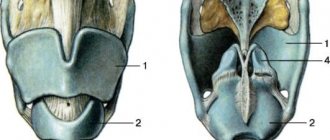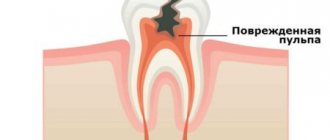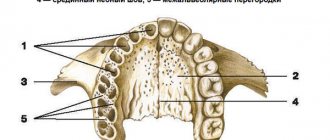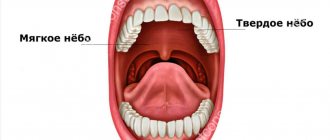Mechanism of disease development
Acute laryngitis is an inflammation of the mucous membrane of the larynx. The larynx is located in the front region of the neck. It connects the pharynx to the trachea and performs three vital functions:
- sound-producing (the vocal apparatus is located in it);
- respiratory;
- protective (prevents food and foreign particles from entering the trachea).
Under the influence of a number of factors (hypothermia, overstrain of the vocal cords, allergies, infectious diseases, etc.), the mucous membrane of the child’s larynx becomes inflamed. As a result, a sharp dilation of blood vessels occurs, edema develops, the lumen of the glottis narrows (or completely closes), speech function is impaired and breathing becomes difficult.
Features of the course of ARVI without fever
A respiratory viral infection is localized in the nasopharynx and after a couple of days it manifests itself as a certain discomfort. Following tickling and sneezing, copious watery discharge from the nose appears, which after a couple of days becomes mucous, sometimes mixed with blood and pus.
Medical statistics indicate that the main symptom of ARVI, with or without fever, is a runny nose. Four out of ten patients experience a sore or sore throat, and six out of ten subsequently develop a cough, which has certain characteristics associated with a cold.
Dry and superficial, it is rather a reaction to tickling. But with weak immunity, there is a possibility of it spreading to the upper respiratory tract. Having descended into the trachea and further into the bronchi, the infection can finally cause fever. Although recently there have been frequent cases of bronchitis and pneumonia occurring without a significant increase in temperature. Needless to say, when symptoms of ARVI complications appear in children, they should definitely be shown to a good pediatrician?
If the sick person also suffers from muscle pain and aches throughout the body, then his temperature will probably rise greatly, since in this case, influenza will most likely be diagnosed - the most serious of acute respiratory viral infections.
Causes of acute laryngitis in children
In order for assistance to a child with acute laryngitis to be as effective as possible, you must first find out what caused the development of the disease. The main provoking factors include:
- ARVI, influenza;
- bacterial respiratory tract infections caused by pneumococcus, staphylococcus, streptococcus, hemophilus influenzae;
- complications after scarlet fever, measles;
- inflammation of the paranasal sinuses;
- local/general hypothermia of the body;
- inhalation of cold, smoky air;
- congenital weakened resistance of the respiratory tract;
- unfavorable environmental conditions;
- contact with allergens;
- uncontrolled use of sprays and aerosols for the throat, leading to a reflex spasm of the larynx in a child;
- overstrain of the vocal cords (strong screaming, loud singing);
- infectious diseases of the oral cavity;
- stress factors.
Etiology
Epiglottitis can be caused by bacterial, viral, and fungal pathogens.
In healthy children, most cases of epiglottitis are caused by a bacterial infection. The most common pathogen is Haemophilus influenzae type b (Hib). Other pathogens are pneumococci, streptococci (including group A beta-hemolytic streptococcus, GABHS), Staphylococcus aureus (including its methicillin-resistant strains, MRSA).
In adults, epiglottitis is associated with a wide range of bacteria, viruses, fungal infections, and combinations thereof.
Among the non-infectious causes of epiglottitis, traumatic ones are most often diagnosed: ingestion of a foreign body, thermal burn, burn with acid or alkali.
Epiglottitis can be one of the manifestations of chronic granulomatous diseases (polyangiitis, sarcoidosis, systemic lupus erythematosus, etc.).
Symptoms of acute laryngitis
In childhood, acute laryngitis develops quite rapidly. At an early stage of the disease caused by a virus, the child experiences:
- general weakness,
- nasal congestion,
- soreness,
- redness of the throat,
- painful swallowing.
In some cases, body temperature may rise to 38–39°C.
Further added to the above symptoms are:
- rhinorrhea (excessive mucus discharge from the nasal passages);
- dry barking cough;
- hoarseness or complete loss of voice.
Over time, during intensive complex treatment of laryngitis, the cough becomes more rare and productive, that is, accompanied by the discharge of sputum.
Acute otitis media
Diagnostic feature
Clinical diagnosis. The sequence of development of acute otitis media is the same as in children of other age groups: catarrhal stage of inflammation, formation of exudate, perforation of the eardrum and suppuration from the ear, development of complications or favorable resolution of the process. The most important symptom of the disease—ear pain—in newborns and infants is detected by changes in the child’s behavior. Acute pain occurs suddenly and is usually so severe that the child holds his breath. Children in the second half of life stop playing and grab their ear with their hand. When sneezing, swallowing, coughing, accompanied by an increase in air pressure in the tympanic cavity, the pain intensifies; sometimes the pain subsides. The child is inhibited, pliable, drowsy. At certain intervals, the painful attack is repeated with the same or greater intensity. Sometimes the child’s restless behavior is replaced by seeming calm, the child sleeps a lot, falls asleep during feeding, and is lethargic, which indicates depression of the nervous system. Body temperature rises; children sleep poorly, often wake up screaming and do not calm down for a long time, shudder, moan. The facial expression is pained, a fixed gaze, painful grimaces. Changing the child's position does not have a calming effect.
A child under 4-5 months cannot localize the pain, only helplessly turns his head. Erratic and obsessive movements are observed: a pendulum-like movement of the head and a “symptom of chewing the tongue.” The reason for these movements is the child’s desire to find an optimal position in which the ear would hurt less. At the height of pain, hand cramps (kapellmeister's position) or false opisthotonus are possible. As intoxication increases, convulsive contractions of the eye muscles may occur. Children in the second half of life reach out with their hands to the sore ear, rub it with the back of their hand, and try to stick their finger into the ear canal. Infants refuse to eat; They are more willing to suckle on the breast opposite the side of the sore ear. Pain when pressing on the tragus is characteristic (Vash's symptom), since pressure is directly transmitted through the non-ossified part of the ear canal to the inflamed eardrum (after a year of life, pain when pressing on the tragus indicates only damage to the external auditory canal).
Complications of acute laryngitis in children
One of the most dangerous complications of acute infectious laryngitis, characteristic of early and preschool childhood, is stenosis (narrowing of the lumen) of the larynx. It is also called false croup or acute airway obstruction. This complication may be due to the structural features of the child’s respiratory tract. Most often it develops against the background of influenza, parainfluenza, adenovirus, measles infection or chickenpox.
When the space under the vocal cords swells, the lumen of the larynx narrows, acute obstruction of the airways occurs, and oxygen deficiency develops. Symptoms of laryngeal stenosis are:
- heavy wheezing,
- barking cough
- hoarseness or complete loss of voice,
- excessive excitement of the child,
- enlarged lymph nodes,
- increase in body temperature,
- the appearance of light dry wheezing.
If you notice these symptoms, you should immediately consult a doctor. But it’s better not to let this happen and start treating acute laryngitis on time.
croup
“Croup”, “acute or recurrent laryngitis/laryngotracheitis”, “acute airway obstruction”, “larynx stenosis” - are the names listed above synonymous or are they independent nosological forms? Every practicing physician should have a clear understanding of what the listed terms mean.
Probably the most widely used term, especially in pediatric practice, is “croup,” and the most general term can be considered “acute airway obstruction,” but in ICD-10 the codes are given according to the “organ principle.”
So, croup (from the Scottish croup - to croak) is an infectious disease syndrome that always implies the presence of acute stenosing laryngitis (or laryngotracheitis, or less commonly laryngotracheobronchitis), accompanied by hoarseness, a “barking” cough and shortness of breath, often of an inspiratory nature. That is, croup is understood as the presence of a certain syndrome with a triad of clinical symptoms: stridor—barking cough—hoarseness. The syndrome is formed in diseases manifested by the development of an acute inflammatory process in the mucous membrane of the larynx and trachea. Therefore, the term “croup” is applicable only to infectious diseases! Domestic pediatricians traditionally divide croup into “true” and “false”, depending on the level of damage to the larynx, although this division is extremely arbitrary, since the mucous membrane of the larynx along its entire length, as well as the mucous membrane of the underlying parts of the respiratory tract, is often involved in the process. “True” croup develops as a result of damage to the true vocal cords (folds). The only example of “true” croup is diphtheria croup, which occurs with the formation of specific fibrinous changes on the mucous membrane of the vocal cords. “False” croup includes all stenotic laryngitis of a non-diphtheria nature, in which the inflammatory process is localized mainly on the mucous membrane of the subglottic (subglottic) zone of the larynx. “Acute laryngitis” is coded J04.0 in ICD-10, “acute laryngotracheitis” is J04.2, “acute obstructive laryngitis” is J05, and “chronic laryngitis” and “chronic laryngotracheitis” are J37.0 and J37.1, respectively. . In any case, it should be understood that acute obstruction of the upper respiratory tract (narrowing of the lumen of the larynx with breathing disorders and the development of acute respiratory failure) is primarily an emergency condition that requires emergency diagnosis and treatment at the prehospital stage.
This condition most often occurs in children of early and preschool age (from 6 months to 3 years, and in 34% of cases - in children of the first 2 years). Acute obstruction is associated with the anatomical and physiological characteristics of the respiratory tract in young children: the narrowness of the lumen of the trachea and bronchi (funnel-shaped instead of cylindrical), the tendency of their mucous membrane and the loose fibrous connective tissue located underneath to develop edema, the peculiarities of the innervation of the larynx, which are associated with the occurrence of laryngospasm, and relative weakness of the respiratory muscles. Swelling of the mucous membrane with an increase in its thickness by only 1 mm reduces the lumen of the larynx by half! The development of acute obstruction of the upper respiratory tract in adults is a fairly rare phenomenon and is usually associated with diphtheria.
There are infectious and non-infectious causes of acute obstruction of the upper respiratory tract. Infectious causes include viral infections (caused in 75% of cases by influenza and parainfluenza viruses of type I, as well as rhinosyncytial viruses, adenoviruses, less commonly measles and herpes viruses) and bacterial infections (with the development of epiglottitis, retropharyngeal and peritonsillar abscess, diphtheria). In this case, the mechanism and routes of transmission of the pathogen are determined by the epidemiological features of the main infectious disease. Aspiration of foreign bodies, laryngeal injuries, allergic edema, laryngospasm can be non-infectious causes of the development of acute obstruction of the upper respiratory tract.
In the genesis of airway obstruction, three factors play a certain role: edema, reflex spasm of the laryngeal muscles and mechanical blockage of its lumen with inflammatory secretion (mucus) or a foreign body (including food, vomit, etc.). Depending on the etiology, the significance of these components may vary. In practical work, in order to conduct adequate therapy and provide effective assistance to a child, it is important to be able to quickly differentiate them.
The main reason for the development of croup is an inflammatory process in the area of the subglottic space and vocal cords (acute stenotic laryngotracheitis). The phenomenon of narrowing of the lumen of the upper respiratory tract during croup is formed sequentially, in stages, and is directly related to the reaction of the laryngeal tissue to an infectious agent, including one that triggers an allergic reaction. When assessing the clinical picture, it is necessary to take into account the prevalence of edema of the inflamed mucous membrane, spasm of the muscles of the larynx and trachea and hypersecretion of mucus, since this is fundamental when choosing treatment tactics.
Breathing disorders due to narrowing of the lumen of the larynx most often occur at night, during sleep, due to changes in the conditions of lymph and blood circulation of the larynx, a decrease in the activity of the drainage mechanisms of the respiratory tract, the frequency and depth of respiratory movements.
The clinical picture of acute stenosis of the upper respiratory tract is determined by the degree of narrowing of the larynx, associated disturbances in respiratory mechanics and the development of acute respiratory failure.
With incomplete obstruction of the larynx, noisy breathing occurs - stridor, caused by intense turbulent passage of air through the narrowed airways. With dynamic narrowing of the airway lumen, normally silent breathing becomes noisy (due to vibrations of the epiglottis, arytenoid cartilages, and partly the vocal cords). When swelling of the laryngeal tissues dominates, a whistling sound is observed; when hypersecretion increases, hoarse, bubbling, noisy breathing is observed; with a pronounced spastic component, the sound characteristics are unstable. It should be remembered that as stenosis increases due to a decrease in tidal volume, breathing becomes less and less noisy!
Inspiratory stridor usually occurs when there is narrowing (stenosis) of the larynx at or above the vocal cords and is characterized by noisy inspiration with retraction of the chest wall. Stenoses below the level of the true vocal cords are characterized by expiratory stridor with the participation of auxiliary and reserve respiratory muscles in breathing. Laryngeal stenosis in the subglottic space usually manifests as mixed inspiratory and expiratory stridor. The absence of voice changes indicates the localization of the pathological process above or below the vocal cords. The involvement of the latter in the process is accompanied by hoarseness or aphonia. A hoarse, “barking” cough is typical of subglottic laryngitis. Other signs of upper respiratory tract obstruction are nonspecific: anxiety, tachycardia, tachypnea, cyanosis, neurovegetative disorders, etc. Rapid breathing and elevated body temperature during croup can lead to significant fluid loss and the development of respiratory exicosis.
Based on the severity of narrowing of the lumen of the larynx, four degrees of stenosis are distinguished, which have significant differences in the clinical picture (see table). However, when making a diagnosis, the severity of the croup is determined primarily, and not the severity of the stenosis (the assessment of the latter is possible with direct laryngoscopy, which is impossible at the prehospital stage). In a comprehensive assessment of the patient’s condition, factors such as the participation of auxiliary muscles in the act of breathing (evidence of a significant narrowing of the airway lumen), symptoms of respiratory and cardiovascular failure, depression of consciousness and persistent hyperthermia should be taken into account.
Thus, the classification of croup is built taking into account:
- etiology of croup (viral or bacterial);
- stages of laryngeal stenosis (compensated, subcompensated, decompensated, terminal);
- nature of the course (uncomplicated or complicated - the appearance of a mixed infection due to the addition of a secondary bacterial purulent infection to the main process).
- with the development of diphtheria croup, the nature of the spread of the inflammatory process is also taken into account (spread to the mucous membrane of the trachea, bronchi and bronchioles is possible - the so-called descending croup).
- recurrence of the syndrome.
DIFFERENTIAL DIAGNOSIS
Diphtheria of the larynx
Diphtheria of the larynx is most often combined with manifestations of this infection in another location (diphtheria of the pharynx or nose), which greatly facilitates diagnosis. The main differences between diphtheria of the larynx and croup that developed against the background of acute respiratory viral infection are the gradual onset and severity of the course with increasing symptoms. The voice with diphtheria of the larynx is persistently hoarse with the gradual development of aphonia. In the treatment of diphtheria of the larynx, along with measures aimed at restoring airway patency, it is necessary to urgently administer anti-diphtheria serum to the child using the Bezredko method in a dose of 40-80 thousand IU per course of treatment, depending on the form of the disease.
Allergic swelling of the larynx
Allergic laryngeal edema is not always possible to distinguish from croup of an infectious nature only by clinical signs. Allergic laryngeal edema develops under the influence of any antigen of inhalation, food or other origin. There are no specific guidelines for ARVI. Fever and intoxication are not typical. These children have a history of various allergic sympathies: skin manifestations of allergies, food allergies, Quincke's edema, urticaria, etc. During therapy with inhaled glucocorticoids with the addition of b2-adrenomimetics (salbutamol - Ventolin), anticholinergics (ipratropium bromide - Atrovent ), combined drugs (a combination of fenoterol and ipratropium bromide - berodual), and also, according to indications, antihistamines, rapid positive dynamics of stenosis occurs.
Laryngospasm
Laryngospasm occurs mainly in children of the first 2 years of life against the background of increased neuromuscular excitability, with manifestations of current rickets with a tendency to tetany. Clinically, spasm of the larynx manifests itself unexpectedly; the child experiences difficulty breathing with a characteristic sound in the form of a “cock crow”, while fear, anxiety, and cyanosis are noted. Mild attacks of laryngospasm are relieved by spraying the child’s face and body with cold water. You should try to induce a gag reflex by pressing on the root of the tongue with a spatula or spoon, or provoke sneezing by irritating the mucous membrane of the nasal passages with a cotton swab. If there is no effect, diazepam should be administered intramuscularly.
Epiglottitis
Epiglottitis is an inflammation of the epiglottis and adjacent areas of the larynx and pharynx, most often caused by Haemophilus influenzae type b. The clinical picture is characterized by high fever, sore throat, dysphagia, muffled voice, stridor and respiratory failure of varying severity. Palpation of the larynx is painful. When examining the pharynx, a dark cherry color of the root of the tongue, its infiltration, swelling of the epiglottis and arytenoid cartilages that close the entrance to the larynx are revealed. The disease progresses rapidly and can lead to complete closure of the lumen of the larynx.
At the prehospital stage, it is optimal to inject a third-generation cephalosporin antibiotic (ceftriaxone) as early as possible. Transport of the child to the hospital is carried out only in a sitting position. You should avoid taking sedatives. You need to be prepared for tracheal intubation or tracheotomy.
Retropharyngeal abscess
Most often, retropharyngeal abscess occurs in children under three years of age. It usually develops against the background of or after an acute respiratory viral infection. The clinical picture is dominated by symptoms of intoxication, severe fever, sore throat, dysphagia, stridor, and drooling. There is no barking, rough cough or hoarseness. Coughing is difficult due to severe pain in the throat. The child often takes a forced position - with his head thrown back. Examination of the pharynx presents significant difficulties due to the child’s severe anxiety and inability to open his mouth. Sedation is used for examination.
Treatment is not carried out at the prehospital stage. Urgent hospitalization to the surgical department is required. In the hospital, the abscess is opened and drained while receiving antibiotic therapy.
Foreign bodies
Foreign bodies of the larynx and trachea are the most common cause of asphyxia in children. Unlike croup, aspiration occurs unexpectedly in the context of apparent health, usually while the child is eating or playing. A coughing attack appears, accompanied by suffocation. The clinical picture depends on the level of airway obstruction. The closer to the larynx the foreign body is located, the greater the likelihood of asphyxia. This location of the foreign body is usually accompanied by the appearance of laryngospasm. The child is scared and restless. During auscultation, you can sometimes hear a popping sound, indicating the release of a foreign body.
After examining the oral cavity and entering the larynx, attempts are made to remove the foreign body by mechanically “knocking out” it. A child under 1 year of age is placed face down with the head end down 60°. With the edge of the palm they give him short blows between the shoulder blades. In children older than one year, sharp pressure with the hand on the abdomen from the midline inward and upward (at an angle of 45°) can be effective. In older children, blows to the back are alternated with sharp compression of the abdomen, clasping the child with the arms from behind (Heimlich maneuver).
If attempts to remove a foreign body using mechanical techniques are ineffective, the issue of urgent intubation or tracheotomy should be addressed.
Treatment of croup
Treatment of croup should be aimed at restoring the patency of the larynx: reducing or eliminating spasm and swelling of the laryngeal mucosa, freeing the lumen of the larynx from pathological secretions.
- Patients are subject to hospitalization in a specialized or infectious diseases hospital if it has an intensive care unit, but treatment should begin at the pre-hospital stage.
- The child should not be left alone; he must be calmed down and picked up, since forced breathing during anxiety or crying increases the symptoms of stenosis and the feeling of fear.
- The room temperature should not exceed 18°C. Effective coughing up of sputum is also facilitated by the creation of an atmosphere of high humidity in the room where the child is located (the “tropical atmosphere” effect), steam inhalation (isotonic NaCl solution through a nebulizer). A warm drink is indicated (hot milk with soda or Borjomi).
- Etiotropic therapy is effective for diphtheria croup - administration of anti-diphtheria serum IM or IV.
- Antibiotics - for diphtheria croup and croup complicated by secondary bacterial infection.
- Expectorant and mucolytic drugs administered primarily by inhalation, for example ambroxol (lazolvan), etc., contribute to the dilution and removal of mucus from the respiratory tract.
- Considering the significant participation of the allergic component in the development of croup, it is advisable to include antihistamines (for example, chloropyramine (suprastin), etc.) in the complex of therapeutic measures. Randomized double placebo-controlled study Gwaltney JM et al. [3] showed that in the treatment of acute respiratory diseases, a combination of antipyretic, antihistamine and antiviral drugs can effectively (33-73% compared with placebo) reduce the severity of various clinical manifestations of the disease, including the amount of mucus produced and pain in the pharynx and larynx . In another work, the same authors [2] demonstrated that clemastine, prescribed in the complex treatment of ARI, in contrast to pheniramine, only increases the sensation of dryness and soreness in the throat. And Gaffey MJ et al. [1] noted no effect from the use of terfenadine in a similar clinical situation.
- Glucocorticoids, for example prednisolone at a dose of 3-10 mg/kg - to relieve swelling of the laryngeal mucosa.
- Psychosedatives - with severe spasm of the laryngeal muscles. For routine treatment of spastic symptoms, tranquilizers are used.
- Intubation and tracheostomy are indicated when conservative therapy is ineffective and during resuscitation measures (asphyxia, clinical death).
So, until recently, therapy for croup was limited mainly to the supply of humidified air and the administration of systemic steroids. However, given the fact that croup most often develops in infants and young children, in whom both oral and injected steroids pose a serious problem, and also that the entire medical community is currently striving to reduce the possible risk of side effects of systemic steroid therapy, the use of inhaled glucocorticoids seems especially promising. To date, vast experience has been accumulated in the treatment of stenosing laryngitis/laryngotracheitis with inhaled budesonide (Pulmicort) through a nebulizer. The effectiveness of this type of therapy was, in particular, discussed by Ausejo et al. a meta-analysis of 24 (!) randomized controlled trials, which also compared the effectiveness of inhaled budesonide and systemic dexamethasone. It was shown that the use of budesonide through a nebulizer for croup compared with dexamethasone by injection significantly reduced the number of cases when the use of adrenaline was considered necessary (by 9%), and also influenced the duration of emergency care both at the prehospital and in-hospital stages . Nebulized administration of budesonide was effective in children with both mild-moderate and moderate-severe croup. Moreover, inhaled single doses (2 or 4 mg) of budesonide were significantly more effective than placebo and were comparable in effectiveness to dexamethasone (0.6 mg/kg). They invariably led to the leveling of lobar symptoms and a decrease in the duration of hospital treatment.
In order to reduce swelling of the mucous membrane of the larynx, which often spreads to the trachea and bronchi, and relieve spasm, b-adrenomimetics can be used simultaneously with budesonide (salbutamol - Salgim, Ventolin, anticholinergics - ipratropium bromide (Atrovent), a combination of b-adrenergic agonists and anticholinergics - berodual).
It should be noted that acute stenosing laryngotracheitis occupies a significant place in the structure of emergency medical calls to children. So, in Moscow last year, parents contacted the ambulance about 198 thousand times. And if we discard cases of acute respiratory infections and influenza (approximately 70 thousand), acute surgical pathology and trauma (58 thousand) and a group of intestinal infections (12 thousand), then of the remaining calls, every ninth or tenth was precisely about the child’s difficulty breathing ( attack of bronchial croup). Moreover, if the frequency of calls for exacerbation of asthma has decreased over the past 3 years, then for croup, on the contrary, it has increased (by about 1000 cases).
In our department of hospital-replacement technologies of the Scientific Center for Children's Health of the Russian Academy of Medical Sciences, where emergency care for children is also provided, over the past 2.5 years (since September 2000), acute stenosing laryngotracheitis has been treated for 100 children (67 boys and 33 girls) aged 6 months up to 7 years. Acute obstruction of the upper respiratory tract developed in 32 children against the background of ARVI, in 5 - during contact with a causally significant allergen, in 8 - against the background of ARVI and physical activity, in 1 - against the background of physical activity and contact with an allergen, in 54 - without visible provoking factors, including ARVI. The parents of all children came to our department, considering this alternative option for emergency care as more effective. All children received inhalations through a nebulizer (two or three times) of budesonide (Pulmicort) at a dose of 1000 mcg, ipratropium bromide (Atroventa) at a dose of 20 drops or the combined drug Berodual at a dose for children under 6 years old - 10 drops, for children over 6 years old - 20 drops drops), mucolytic drug lazolvan (in a dose of 20 drops in an isotonic NaCl solution.
The effectiveness of the first inhalation of budesonide was noted in 53% of children (within 15-25 minutes after inhalation, breathing calmed down, shortness of breath, painful non-productive “barking” cough disappeared, and anxiety decreased). 44 children needed 2–3-day courses of inhalation therapy, and only in 3 patients the effect was achieved on the 4–5th day. Thus, budesonide, administered in inhalation through a nebulizer, can be considered a highly effective drug for emergency treatment of acute upper respiratory tract obstruction in children of any age, including at the prehospital stage.
L. S. Namazova, Doctor of Medical Sciences N. I. Voznesenskaya A. L. Vertkin, Doctor of Medical Sciences, Professor of the Scientific Center for Children of the Russian Academy of Medical Sciences, MGMSU, NNPOSMP, Moscow
Literature
- Gaffey MG, Kaiser DL, Hayden FG Ineffectiveness of oral terfenadine in natural colds: evidence against histamine as a mediator of common cold symptoms // Pediatr. Infect. Dis. J. 1988. V. 7(3) Mar. P. 223-228.
- Gwaltney JM Jr., Park J., Paul RA et al. Randomized controlled trial of clemastine fumarate for treatment of experimental rhinovirus colds.
- Gwaltney JM Jr., Winther B., Patrie JT, Hendley JO Combined antiviral-antimediator reatment for the common cold // J. Infect. Dis. 2002. V. 186(2). Jul 15. P. 147-154.
Diagnosis of the disease
Diagnosis of acute laryngitis is not particularly difficult. The diagnosis is based on the presence of acute respiratory infections symptoms, as well as hoarseness, shortness of breath, and barking cough. Call a doctor: he will listen to complaints, examine the child, measure the temperature, listen to the lungs and make a diagnosis.
Why does Quincke's edema occur?
Histamine is a special substance in the human body. It is found in mast cells of connective tissue, spleen, lymph nodes, and bone marrow. After inflammation has occurred, mast cells are activated and release a charge of histamine into the blood. Histamine increases the permeability of vascular walls and dilates capillaries. Blood flow slows down, swelling of the skin tissue appears. For example, with Quincke's edema, the process involves the deep layers of the skin, and with urticaria, only the upper ones. In both cases, accumulations of inflammatory cells (lymphocytes and neutrophils) appear at the site of histamine action.
Quincke's edema appears as a result of non-allergic, allergic and mixed mechanisms:
- Non-allergic reactions occur most often in children. Histamine is released due to exposure to food dyes, medications, and after an insect bite.
- With the allergic mechanism, an allergen enters the body, which is accepted by the body as hostile and launches an attack of immunoglobulins (antibodies) against it. These antibodies attach to the mast cell membrane. Antibodies have a good specific memory; they know exactly what the antigen looks like. If the allergen enters the body again, it binds to the antibody and the mast cell releases histamine. Therefore, Quincke's edema develops precisely when the allergen is repeatedly exposed.
- The mixed form includes hereditary angioedema. The nature of this manifestation may be hereditary, if one of the relatives has previously experienced swelling of the larynx and other organs.
Non-drug therapy
Treatment of acute laryngitis depends on the age of the child. This may include:
- compliance with bed rest;
- limiting vocal load (for 5–7 days it is better for the baby to remain silent or talk as little as possible);
- maintaining the optimal temperature (+18…+20°C) and air humidity (50–70%) in the room where the sick child is located;
- drink plenty of fortified drinks (the liquid should be warm and unsweetened);
- following a hypoallergenic diet - if there are symptoms of laryngitis, it is strictly not recommended for a child to give sour, spicy, too hot or cold foods and carbonated drinks.
When treating inflammation of the mucous membrane of the larynx, children are allowed to apply wet and dry warming compresses to the neck area and gargle with a warm infusion/decoction of chamomile or sage, if recommended by a doctor.
Why do cold symptoms vary from person to person?
The manifestations of the disease depend on the combination of the above factors. As a rule, a person may initially have a sore throat, a runny nose and a fever. Most patients consider only a rise in temperature to be a more or less serious symptom, and in its absence, sore throat, runny nose and even cough are ready to endure on their feet. The idea that bronchitis and even pneumonia may be hidden behind a cough occurs to the average patient only at elevated temperatures. Why doesn’t the immune system respond by increasing it in all cases?
- The severity of the reaction is determined by the type of pathogen that has entered the body. Thus, the body almost always reacts to infection by strains of influenza and some other aggressive viruses with an elevated temperature.
- An increase in temperature means that the immune system has begun to do its job, producing antibodies. But in some patients with weakened immunity, an immune response is not formed, and there is no fever during ARVI. This may mean that the body is infected with a rather dangerous virus that it is not able to fight on its own.
- Modern “anti-cold” pharmaceutical drugs based on paracetamol, which people with colds like to prescribe to themselves, quickly relieve cold symptoms, especially quickly coping with elevated temperatures. But they do not destroy pathogenic viruses and do not strengthen the immune system, which means they do not help the body overcome ARVI.
Drug therapy
How to fight infection?
Drug therapy for laryngitis that appears in a child against the background of an acute respiratory infection includes the use of antiviral and immunomodulatory drugs.
Antihistamines, which are usually prescribed for allergies, help relieve swelling of the mucous membrane and calm the baby. They should be given before bedtime, strictly according to the recommendation of the attending physician. What to do if you have a cough?
Remedies for this symptom are another essential component of treatment.
In the early stages of laryngitis, if a child has a dry hacking cough, drugs that block the cough center are used. Next, at the first signs of coughing, mucolytics are prescribed to thin the mucus and improve expectoration of sputum. Doctor MOM® cough syrup has similar properties. This complex herbal medicine, containing extracts of 10 medicinal plants, helps not only to liquefy mucus, but also to relieve swelling and inflammation. Herbal syrup is approved for long-term use in the treatment of laryngitis in children over 3 years of age. Actions at temperature.
If a child has a hard time tolerating a high temperature, he is prescribed an antipyretic. Treatment of laryngitis with antibiotics is justified only in the presence of serious bacterial complications and only as prescribed by a doctor.
Why does ARVI selectively affect people?
Having been chilled outside, we try to warm up at home with hot tea and take a bath, but, unfortunately, these simple but effective procedures do not help everyone. This fact is explained by the general health of a particular person. Hypothermia of the body only triggers the mechanism of a cold, but the nature of the further development of the disease is determined by other reasons.
- A hypothermic body is easily affected by respiratory viruses, including the influenza virus. Entering into a favorable environment, pathogenic microflora begins to actively multiply.
- Susceptibility to infection is largely determined by the state of the immune system. For example, chronic diseases significantly weaken the body’s ability to fight viruses and bacteria that have entered it.
- Patients with enlarged tonsils or with constantly inflamed sinus mucosa are much more likely to be exposed to ARVI. Hypothermia will cause an exacerbation of chronic diseases in them.
- The state of the gastrointestinal tract also affects the level of immunity. The likelihood of catching a cold increases significantly with dysbiosis caused by taking antibiotics or internal causes.
- It is no secret that the likelihood of contracting ARVI increases when a person is in a stressful situation and experiences strong psycho-emotional stress.
The body's reaction to the active activity of pathogenic microflora will also be different.
Causes of Quincke's edema
There are many medications that can cause hives or swelling. These may be anticonvulsants, acetylsalicylic acid, antibiotics, iodine preparations, B vitamins, medicinal serums, sulfites, corticosteroids, eye medications, bronchodilators.
Anti-inflammatory nonsteroidal drugs increase skin sensitivity to histamine. This group of drugs is very dangerous for children prone to allergies. Atopic dermatitis and bronchial asthma will increase the risk of developing Quincke's edema.
Many food products, or rather the additives contained in them, also cause an allergic reaction. Such allergenic additives include monosodium glutamate, sulfites, tartrazine dye, etc. Allergies can be caused by Chinese dishes; of course, children are not given seafood, but cases of angioedema caused by the smell of fish have been observed.
Fish, strawberries, lemons, egg whites, bananas, and chocolate contain substances that release intracellular histamine. This is why these foods should not be given to children under three years of age. Some foods themselves contain large amounts of histamine: sausages, sauerkraut, cheese. Hereditary complications, gastrointestinal diseases, allergic reactions in the mother during pregnancy increase the possibility of angioedema.
Quincke's edema can appear from plant pollen. Children from three to nine years old can develop hay fever, an allergic disease caused by hypersensitivity to plant pollen. According to statistics, in 11% of children who suffer from hay fever, the disease is complicated by Quincke's edema.
Insect bites can also cause angioedema. Insect saliva contains histamine and other substances. If parents were allergic to insect bites, then it is better to protect children from this.
Why are vocal cords easily injured during inflammation?
There are two true vocal cords. At rest, they are at a fairly large distance from each other, forming a triangle with a wide base and coming together only in the area of the anterior ends (at the point of their connection), while the edge of each vocal cord is free.
When producing sound (and when coughing), the vocal cords come closer and touch each other. During inflammation, the edges of the vocal cords are swollen, inflamed and very easily injured during voice formation, as well as when coughing, which can not only increase their inflammation, increase the duration of the recovery process of the vocal cords, but also contribute to the chronicity of inflammation and provoke the appearance of benign neoplasms along the edge of the vocal cords , coarsening of the edges of the vocal cords and, as a result, a change, deepening of the voice. Therefore, it is so important to remain silent during their inflammation, maintaining a safe distance between the vocal cords, avoiding their traumatization.










